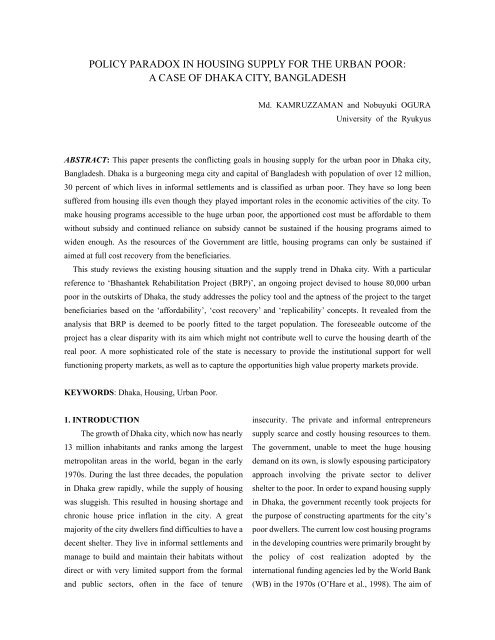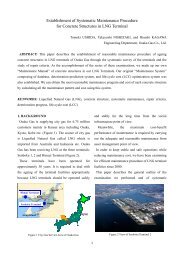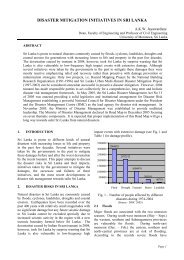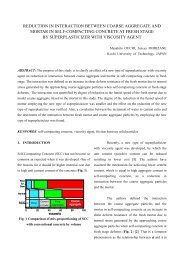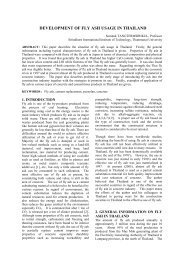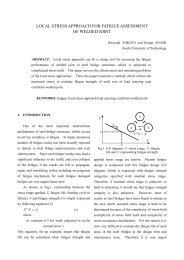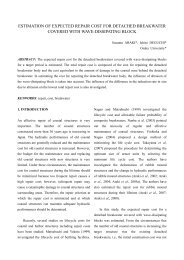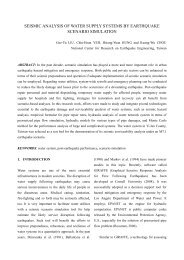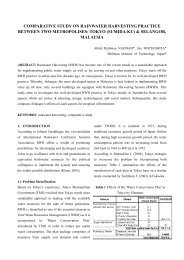POLICY PARADOX IN HOUSING SUPPLY FOR THE URBAN POOR ...
POLICY PARADOX IN HOUSING SUPPLY FOR THE URBAN POOR ...
POLICY PARADOX IN HOUSING SUPPLY FOR THE URBAN POOR ...
Create successful ePaper yourself
Turn your PDF publications into a flip-book with our unique Google optimized e-Paper software.
<strong>POLICY</strong> <strong>PARADOX</strong> <strong>IN</strong> HOUS<strong>IN</strong>G <strong>SUPPLY</strong> <strong>FOR</strong> <strong>THE</strong> <strong>URBAN</strong> <strong>POOR</strong>:<br />
A CASE OF DHAKA CITY, BANGLADESH<br />
Md. KAMRUZZAMAN and Nobuyuki OGURA<br />
University of the Ryukyus<br />
ABSTRACT: This paper presents the conflicting goals in housing supply for the urban poor in Dhaka city,<br />
Bangladesh. Dhaka is a burgeoning mega city and capital of Bangladesh with population of over 12 million,<br />
30 percent of which lives in informal settlements and is classified as urban poor. They have so long been<br />
suffered from housing ills even though they played important roles in the economic activities of the city. To<br />
make housing programs accessible to the huge urban poor, the apportioned cost must be affordable to them<br />
without subsidy and continued reliance on subsidy cannot be sustained if the housing programs aimed to<br />
widen enough. As the resources of the Government are little, housing programs can only be sustained if<br />
aimed at full cost recovery from the beneficiaries.<br />
This study reviews the existing housing situation and the supply trend in Dhaka city. With a particular<br />
reference to ‘Bhashantek Rehabilitation Project (BRP)’, an ongoing project devised to house 80,000 urban<br />
poor in the outskirts of Dhaka, the study addresses the policy tool and the aptness of the project to the target<br />
beneficiaries based on the ‘affordability’, ‘cost recovery’ and ‘replicability’ concepts. It revealed from the<br />
analysis that BRP is deemed to be poorly fitted to the target population. The foreseeable outcome of the<br />
project has a clear disparity with its aim which might not contribute well to curve the housing dearth of the<br />
real poor. A more sophisticated role of the state is necessary to provide the institutional support for well<br />
functioning property markets, as well as to capture the opportunities high value property markets provide.<br />
KEYWORDS: Dhaka, Housing, Urban Poor.<br />
1. <strong>IN</strong>TRODUCTION<br />
The growth of Dhaka city, which now has nearly<br />
13 million inhabitants and ranks among the largest<br />
metropolitan areas in the world, began in the early<br />
1970s. During the last three decades, the population<br />
in Dhaka grew rapidly, while the supply of housing<br />
was sluggish. This resulted in housing shortage and<br />
chronic house price inflation in the city. A great<br />
majority of the city dwellers find difficulties to have a<br />
decent shelter. They live in informal settlements and<br />
manage to build and maintain their habitats without<br />
direct or with very limited support from the formal<br />
and public sectors, often in the face of tenure<br />
insecurity. The private and informal entrepreneurs<br />
supply scarce and costly housing resources to them.<br />
The government, unable to meet the huge housing<br />
demand on its own, is slowly espousing participatory<br />
approach involving the private sector to deliver<br />
shelter to the poor. In order to expand housing supply<br />
in Dhaka, the government recently took projects for<br />
the purpose of constructing apartments for the city’s<br />
poor dwellers. The current low cost housing programs<br />
in the developing countries were primarily brought by<br />
the policy of cost realization adopted by the<br />
international funding agencies led by the World Bank<br />
(WB) in the 1970s (O’Hare et al., 1998). The aim of
this study is to evaluate the policy tool to the supply<br />
housing for the urban poor based on<br />
‘affordability–cost recovery–replicability’ concepts.<br />
2. POPULATION GROWTH AND HOUS<strong>IN</strong>G<br />
PROBLEM <strong>IN</strong> DHAKA CITY<br />
2.1 Population Growth and Concentration<br />
Dhaka is the tenth largest urban agglomerations in<br />
the world with second fastest rate of population<br />
growth and has become one of the mega cities of the<br />
world (UN, 2004). The average annual growth rate<br />
of Dhaka city’s population during the last three<br />
decades has been over 7 percent, thus doubling its<br />
population every decade. From a humble beginning<br />
as a small colonial town, Dhaka emerged as a<br />
prominent city when it was selected to be the capital<br />
of Bangladesh in the 1970s. The result was that<br />
while overall urban population growth averaged<br />
5.4% between 1981 and 1991, Dhaka’s growth<br />
averaged 6.5%. Since 1991, Dhaka’s population has<br />
been experiencing growth rate of 4.3% compared to<br />
a national average of 3.2% (Table. 1).<br />
Table 1. Population, Growth Rate and Density in Dhaka<br />
Year<br />
Population<br />
(million)<br />
Annual<br />
Growth<br />
Rate (%)<br />
Total Area<br />
(sq. km)<br />
Gross<br />
Density<br />
(per./km 2 )<br />
1974 2.0 10.4 336 6,156<br />
1981 3.4 8.1 509 6,759<br />
1991 6.4 6.5 1,353 4,795<br />
2001 9.9 4.3 1,464 6,771<br />
Source: BBS, 2001, 2005<br />
2.2 Housing Shortage and Situation in Dhaka<br />
The ever-increasing number of people and<br />
industries within the Dhaka city has created a serious<br />
housing shortage. The imbalance between the total<br />
number of households and the total housing stock is<br />
often referred to as the great housing shortage in<br />
Dhaka. In table 2, it is shown that the quantity of<br />
houses is considerably below the number of<br />
households. The growth of dwelling stock was<br />
inadequate to cope with the increasing population and<br />
the intensifying housing need in Dhaka. As a result,<br />
the ratio of dwelling to households in Dhaka was 0.71<br />
in 2001.<br />
Table 2. Population, Households & Housing Stock, 1991-2001<br />
Bangladesh Dhaka<br />
Variables<br />
1991 2001 1991 2001<br />
Population (million) 106.3 123.2 6.4 9.9<br />
Households (million) 19.3 25.4 1.1 2.1<br />
Household Size 5.5 4.8 5.5 4.7<br />
Housing Stock (million) 16.3 18.9 1.0 1.5<br />
Source: Complied from BBS (2001) and Hoek-Smit (1998)<br />
The growth in housing supply has always lagged<br />
behind the demand. This has resulted in<br />
overcrowding with high occupancy rates and high<br />
room density. The unsatisfactory housing situation is<br />
further reflected in the total and per capita<br />
availability of floor space of the main living area.<br />
The average floor space per person is 3.7m 2 . In Dhaka<br />
about 70% of the total housing stock is rented (ADB,<br />
1997). The Bangladesh Bureau of Statistics (BBS)<br />
has categorized urban housing types into<br />
cement/brick, corrugated iron/metal sheet,<br />
mud/unburnt brick, straw/bamboo. Eighty-nine per<br />
cent of poor households in Dhaka live in one-roomed<br />
homes of the latter types. In the densely populated<br />
slums of Dhaka, the floor area per person is as small<br />
as 1.2m 2 . In short, the poor in Dhaka city live in<br />
impoverished conditions lacking access to land,<br />
shelter and basic urban services.<br />
What is more important, for the concerns of this<br />
paper, is that a significant proportion of the urban<br />
population can be categorized as poor and live in<br />
informal settlements. According to an estimate by<br />
Islam (2005), in Dhaka around 35% of the people<br />
lived below the poverty line, out of which around<br />
20% were classified as “hardcore poor” who lived in<br />
informal settlements. Lack of tenure security and
poor quality of housing is a direct indicator of these<br />
settlements.<br />
2.3 Housing Cost<br />
This high price of land in Dhaka acts as a<br />
prohibitive factor in the supply of housing to all but<br />
the highest-income groups. On account of high price<br />
of land, lower middle-class Households (HHs), who<br />
are actually majority in cities, are virtually kept out of<br />
the land market (ADB, 1997). The Bangladesh Urban<br />
0 2 4 km<br />
Land Price in Dhaka, 2005<br />
270 US$/sq. m<br />
335 US$/sq. m<br />
550 US$/sq. m<br />
670 US$/sq. m<br />
Fig. 1 Residential Land Price in Dhaka<br />
(Source: Field Survey, 2006)<br />
N<br />
780 US$/sq. m<br />
1,340 US$/sq. m<br />
1,560 US$/sq. m<br />
and Shelter Sector Review shows that in Dhaka, the<br />
price of un-serviced and undeveloped land would be a<br />
minimum of US$ 3 per sq. m, with that of serviced<br />
land around US$ 45 to 66 per sq. m. The price of<br />
prime serviced land is around US$ 1,615 per sq. m in<br />
the central business district. Fig. 1 provides some<br />
idea regarding land value in 2005. Residential land<br />
values in prime locations of Dhaka range between<br />
US$ 550 and 1,560 per sq. m. These figures prove<br />
that land prices are too high compared to other cities<br />
developing countries.<br />
2.4 Housing Providers in Dhaka<br />
The Household and Expenditure Survey (1988-89)<br />
confirmed that 93 percent of all housing in Dhaka<br />
was provided through the private sector. The public<br />
sectors’ contribution is too insignificant and<br />
government’s policy is to act as an enabler in order<br />
to increase access to land and other supporting<br />
facilities especially for low and middle-income<br />
groups and the construction of housing will<br />
generally be left to the private sector and the people<br />
themselves.<br />
The private housing market is dominated by small<br />
scale, self built housing. In the absence of<br />
well-established formal land and housing markets in<br />
Dhaka city, informal sector has been playing the<br />
major role to cater the housing needs. Small-scale<br />
builders and developers, (self-help) owner-builders<br />
operating in the informal private sector, are the<br />
largest suppliers of land and shelters in Dhaka.<br />
Around 92% of urban land and 96.5% shelter units<br />
are provided through the informal sector. In Dhaka<br />
the rental sub-market in informal settlements is the<br />
single largest supplier of housing.<br />
Table 3. Population in Informal Settlements in Cities<br />
City Population No. of Settlements<br />
Dhaka 3.50 (million) 4,300<br />
Chitagong 1.83 (million) 1,814<br />
Khulna 0.17 (million) 470<br />
Rajshahi 0.15 (million) 539<br />
Source: Ahmed (2007)<br />
The informal sector includes the provisions of<br />
both sub-illegally and illegally constructed housing.<br />
Sub-illegal housing supply includes the housing<br />
constructed on legally occupied land but violating<br />
building codes. It is evident from the Table 3 that the<br />
number of people living in informal settlements, as<br />
well as the number of these settlements is
significantly high in Dhaka city over the other four<br />
large cities of Bangladesh. These informal housing<br />
developed on own land is affordable to the poor. The<br />
informal sector holds the role of largest housing<br />
supplier in Dhaka, both in the rental and ownership<br />
sector.<br />
This dominance of the informal delivery systems<br />
over the formal system is also highlighted by a<br />
breakdown of the housing stock into sub-categories.<br />
The informal sector is estimated to have produced 85<br />
percent of the 1.0 million housing units in the city<br />
(Table 4). The highest segment (85%) of urban<br />
housing stock belongs to informal sector; including<br />
50% of the stock belongs to permanent shelter (Table.<br />
4). While self-construction accounts for half of the<br />
total stock, slums and squatter settlements represent<br />
the other 35 percent of it.<br />
Table 4. Relative Importance of Housing Providers in Dhaka<br />
Housing Sub-sector Units (%)<br />
Public housing 100,000 (10%)<br />
Formal Private Housing 48,000 (4.8%)<br />
Sector Cooperative 2,000 (0.2%)<br />
Total Formal Sector 150,000 (15%)<br />
Private Housing 500,000 (50%)<br />
Informal Slums 200,000 (20%)<br />
Sector Squatter Settlements 150,000 (15%)<br />
Total Informal Sector 850,000 (85%)<br />
housing for the urban poor tended to follow the<br />
“western” models of slum clearance and the building<br />
of public-sector replacement apartment blocks. The<br />
former usually served to do no more than shift the<br />
slum problem around the city, and the latter almost<br />
invariably turned out to be housing that could not be<br />
afforded by the urban poor (Pugh, 1989). The current<br />
WB’s approach was based upon following the<br />
implications of three relatively simple concepts —<br />
“affordability”, “cost recovery” and “replicability”.<br />
In the 1980s, a number of Indian cities became the<br />
“laboratories” in which this new approach of the WB<br />
was tested (Pugh, 1990).<br />
4. CASE STUDY: BRP <strong>IN</strong> DHAKA CITY<br />
The Government of Bangladesh (GoB) has taken<br />
up Bhashantek Rehabilitation Project to provide<br />
housing for the Slum Dwellers (SD), who have so<br />
long been objects of neglect and suffered even<br />
though they played important roles in the economic<br />
activities of the city. The project is expected to<br />
provide shelter to more than 80,000 urban poor. This<br />
is the first, in its type, joint venture rehabilitation<br />
project by the Government and private organization.<br />
GoB has provided land at Bhashantek in the outskirts<br />
of the city. Around one third of the project has been<br />
completed and its final completion is expected to be<br />
within December, 2009 (Fig. 2).<br />
Total 1,000,000 (100%)<br />
Source: Estimates from Islam (2004)<br />
3. REVIEW OF HOUS<strong>IN</strong>G <strong>POLICY</strong> <strong>IN</strong> <strong>THE</strong><br />
DEVELOP<strong>IN</strong>G WORLD<br />
From the end of the 19th century and up to the<br />
1970s, housing policy for the urban poor in many<br />
developing countries often imitated that in developed<br />
countries. Considerable faith was placed in<br />
borrowing models of planning. All too often,<br />
however, these plans were divorced from the reality<br />
on the ground (Devas, 1993). Policy with regard to<br />
Fig. 2 Housing Project for the Urban Poor at BRP,<br />
Total land area of BRP is 20 hector where 15,024<br />
apartment units will be constructed. Gross dwelling<br />
units density is 748 dwelling unit/ha. Residential<br />
land coverage is about 58% of total land.
Government is providing the total land for the<br />
project which costs about US$ 50 million. The land<br />
price at project location is about US$ 254 per sq. m<br />
and the selling price of apartment units is US$ 160<br />
per sq. m.<br />
The project has been planned for implementation<br />
in co-ordination with government land, investment<br />
of private companies and deposits from the<br />
beneficiaries. The private developer has developed<br />
the land and constructing affordable low-cost flats<br />
for poor people who would pay the costs in<br />
installments. But the condition of the SDs appeared<br />
to be really tough to pay the monthly installment.<br />
Existing housing finance system is also not<br />
supportive to access housing loan for them.<br />
Two types of 6-storied buildings are being<br />
constructed for the poor in the project. The 18.75 sq.<br />
m type-A flats are for SDs and 28 sq. m type-B flats<br />
are for the Low Income Groups (LIGs) (Fig. 3).<br />
Type-A flat has one room with a kitchen and a toilet;<br />
and type-B flat has two rooms, one kitchen and one<br />
toilet. There is a small veranda in both types of flats.<br />
Initially it was decided that 60 percent of the<br />
dwelling unit would be for the SDs and the rest for<br />
low-income families and low-paid government<br />
employees.<br />
Kitchen<br />
1.4 x<br />
1.6m<br />
Bed Room<br />
3.6 x 2.6m<br />
Toilet<br />
1.2 x<br />
1.6m<br />
1.2 m Wide Corridor<br />
Type-A for SDs<br />
Toilet<br />
1.3 x<br />
1.7m<br />
Bed Room<br />
3.0 x 2.9m<br />
Kitchen<br />
1.5 x<br />
1.7m<br />
Drawing /<br />
Dining<br />
3.4 x 2.9m<br />
1.2 m Wide Corridor<br />
Type-B for LIGs 0 1 2 3m<br />
Fig. 3 Floor Plans of the Dwelling Units at BRP<br />
5. ANALYSIS OF <strong>THE</strong> PROJECT<br />
Here the study provides an analysis of the BRP<br />
and the problems they present. The evaluation is<br />
made on WBs trilogy: affordability, cost recovery<br />
and replicability.<br />
Affordability meant adopting a realistic approach<br />
to housing supply in terms of what the urban poor<br />
could really afford, recognizing that, initially at least,<br />
the standards of these housing would fall way below<br />
conventional norm. Cost-recovery is related to the<br />
concept of affordability in that it implied a ‘user<br />
pays’ policy rather than the adoption of subsidies.<br />
The standards provided would then be based on what<br />
could be afforded by consumers, rather than on<br />
design ideals. Replicability completes the apparent<br />
process of logic in this approach in that, if costs are<br />
recovered because they are affordable to the groups<br />
affected, then the successful repetition of such<br />
projects becomes likely, leading to overall<br />
improvement in housing provision.<br />
5.1 Affordability<br />
In this section, it is attempted to measure the actual<br />
level of affordability as affordability equation often<br />
calculated theoretically which exceeds the capability<br />
of the low-income beneficiaries in reality. In the<br />
developed countries, housing cost is considered equal<br />
to 30-36 months’ income in order to calculate<br />
recovery and return (Jorgensen, 1977). Housing<br />
prices can neither be determined rationally in relation<br />
to incomes of the target groups, nor does income limit<br />
by prices, since there are wide variations between<br />
individual HH’s propensities to pay and access to<br />
resources.<br />
House Price to Income Ratio<br />
12<br />
9<br />
6<br />
3<br />
0<br />
BHP Apartments<br />
Other Cheap Apartments<br />
19 sq.m Unit for<br />
Slum Dwellers<br />
28 sq.m Unit for<br />
LIGs<br />
Fig. 4 House Price-Income Ratio at BRP
The house price to income ratio of BRP apartment<br />
units is found to be 4.4 and 4.3 for the SDs and LIGs<br />
respectively. The house price to income ratio of BRP<br />
apartment and other average cheap apartment having<br />
same floor area for the two distinct groups is<br />
compared in Fig. 4. It is evident from Fig. 4 that BRP<br />
apartments costs half or less than half in comparison<br />
with other cheap apartments at a market price.<br />
House Rent to Income Ratio<br />
60<br />
50<br />
40<br />
30<br />
20<br />
Left Y-Axis: Rent-Income Ratio<br />
Right Y-Axis: Ave. Floor Area<br />
Slum Dwellers<br />
LIGs<br />
Fig. 5 House Rent-Income Ratio for the SDs & LIGs<br />
Theoretically, these units are affordable to the<br />
target population, if house price to income ratio is<br />
considered only. Another important parameter to<br />
measure of housing affordability is house rent to<br />
income ratio. Other studies affirm that house rent<br />
covers about 53% of monthly household income to<br />
the SDs and 43% to the LIGs (Fig. 5). As depicted in<br />
Fig. 5, the average rental floor area of the two income<br />
groups are 22m 2 and 42m 2 respectively and it also<br />
evaluates the aptness of the dwelling unit’s size of<br />
BRP. It reveals that the BRP dwelling units are almost<br />
equal in size to the general rental floor area of the two<br />
income groups.<br />
The affordability issue has been treated variously<br />
for the lower-income groups, and failures have been<br />
ascribed to wrong estimation. If the HHs’<br />
affordability is estimated properly, housing projects<br />
could be sustained by setting the standard at<br />
appropriate level and optimizing the resource usage<br />
that are expensive in one way and in excruciatingly<br />
60<br />
50<br />
40<br />
30<br />
20<br />
Floor Area, sq.m<br />
Housing Price, US$<br />
short supply on the other way, and thus ensuring full<br />
cost recovery.<br />
The project sale apartment units to the<br />
beneficiaries in an understanding that they will repay<br />
the installment no more than 5 years despite there is<br />
no external finance either from the Government’s<br />
side or from the developers’ end. The individual HHs<br />
need to cover this expense from savings or other<br />
private effort. Thus it appears that it is quite difficult<br />
to own an apartment with savings only for the low<br />
income people. More than 80 percent of the target<br />
population will not be able to own these apartments<br />
due to poor affordability and lack of finance for the<br />
target population even though these are cheap<br />
enough.<br />
5.2 Cost Recovery<br />
As the resources of the Government are little,<br />
housing programs can only be sustained if aimed at<br />
full cost recovery from the beneficiaries. Land and<br />
construction cost cover the major portion of the total<br />
investment and here this two elements among others<br />
are considered in order to analyze the recovery<br />
estimation. In BRP, land is supplied by the<br />
government for the low income population for free.<br />
Government will take the registration cost only from<br />
the beneficiaries and virtually there has negligible<br />
return. Hence it can be treated as a highly subsidized<br />
project.<br />
7,000<br />
6,000<br />
5,000<br />
4,000<br />
3,000<br />
2,000<br />
1,000<br />
0<br />
LIG - Expending 40% of Income<br />
LIG - Expending 35% of Income<br />
Poor - Expending 45% of Income<br />
Poor - Expending 40% of Income<br />
1 3 5 7 9 11 13<br />
Year of Income<br />
Fig. 6 Homeownership at Different Monthly<br />
Expenditure Rate by the Target Population
Construction cost of the whole project is being<br />
carried on by the private developer. The final<br />
beneficiaries of the project will be selected by<br />
drawing lots out of many applied applicants who will<br />
be allowed to pay the total cost with no more than 60<br />
installments. The private developer will not hand over<br />
the legal documents for ownership of the apartments<br />
unless the beneficiaries complete their payment.<br />
From this perspective, it is assumed that developers’<br />
will be able to recover their capital. But the<br />
repayment calculation of the beneficiaries is different.<br />
Total cost of the dwelling units are equivalent to<br />
amortize 40 percent of monthly income devoted to<br />
housing for 10.6 and 10.8 years for the SDs and LIGs<br />
respectively and the detail is explored in Fig. 6. A<br />
lower expenditure will obviously require more<br />
repayment period. It will be very difficult to repay the<br />
unit cost by the beneficiaries within 5 years and<br />
within the prevailing financial situation. Banking<br />
criteria rarely allow for loans to be granted on the<br />
basis of anything other than regular and documented<br />
income. Thus the beneficiaries will be in<br />
disadvantageous state to repay the cost and<br />
foreseeable recovery of the BRP is questionable.<br />
5.3 Replicability<br />
The current policies of international funding<br />
agencies are based on cost recovery and revolving.<br />
Land, infrastructure, finance and utilization of active<br />
housing supply energy remain the key issue to<br />
replicate housing programs for the urban poor in the<br />
Dhaka city besides the common issue of<br />
affordability and cost recovery.<br />
Housing encompasses large direct and indirect<br />
costs of numerous components, which are variables in<br />
the eventual financial composition of a shelter<br />
program. It is axiomatic that the land cost is the first<br />
debit from the sum total of what can be afforded. If<br />
land is under-priced it will amount to a subsidy. An<br />
unaffordable project can reach the target group only<br />
with subsidy; continued reliance on subsidy for an<br />
indefinite period cannot be sustained. An individual<br />
cannot organize land servicing successfully. The<br />
poorer section of society is politically less able to<br />
ensure that they are provided with infrastructure out<br />
of regular budgets and thus it is realistic that they<br />
themselves finance these. Again, subsidies in the<br />
developing world go mostly to the rich who could<br />
influence the resource allocation to favor them, not<br />
those whom these are for (Rahman, 2001). In this<br />
consequence it may be deemed that the real poor<br />
might be deprived at BRP as land; the most costly<br />
resource, is supplied for free. It will remain a major<br />
hurdle to revolve housing projects if land is to<br />
supply without any cost; especially when land value<br />
in Dhaka is extremely high.<br />
To make a housing program accessible to the<br />
target HHs, the apportioned cost must be affordable<br />
to them. If the project is aimed to homeownership,<br />
then it should have some provision of external<br />
finance. Otherwise it will be difficult to revolve<br />
housing schemes for the urban poor as the occupant’s<br />
invest from savings will be beyond the limits set by<br />
the project criteria. It is evident from the example of<br />
BRP that the target population will find difficulty to<br />
attain home ownership mainly due to lack of external<br />
finance despite the apartments are cheap and<br />
eventually difficult to repay.<br />
6. CONCLUSION<br />
The experience of housing program for the urban<br />
poor in Dhaka city, as narrated in this paper, is about<br />
the success or failure of a housing strategy.<br />
Involvement of public sector as direct housing<br />
supply has limited potential. The case, nonetheless,<br />
reveals the hidden realities involved in the project<br />
and plausible outcome of such housing delivery. This<br />
paper focuses on the paradoxes in public policy and<br />
the role of government in an enabling approach.<br />
Housing scarcity is acute, complex and a universal
problem in the developing world. Policies to supply<br />
shelter seem to be ill suited to the realities of cities<br />
where nearly all housing is produced by private or<br />
community efforts. The role of government in<br />
housing is very different from traditional policy<br />
maker because a policy without the realities is<br />
destined to fail. Nowhere is this situation seen more<br />
vividly than in the cities of the developing countries.<br />
Dhaka is one such city where the gap between the<br />
strategies to supply shelter vis a vis effective regain to<br />
lessen the shelter crisis is more vibrant.<br />
Based on the analysis and outcomes of this study,<br />
the following conclusions can be drawn to formulate<br />
policies and programs to lessen housing dilemma in<br />
Dhaka city.<br />
First, housing in a form of permanent shelter is<br />
extremely expensive for the low income population.<br />
Specifically, land price in Dhaka city is too high and<br />
it results home ownership beyond the limit of the<br />
study population.<br />
Second, apartment units at BRP are quite<br />
low-priced as the project is highly subsidized. There<br />
has absence of formal finance for the beneficiaries to<br />
repay the unit price. Due to lack of formal finance,<br />
home ownership for the low income population<br />
remains difficult even though these dwelling units<br />
are cheap. Capital investment may be regained by<br />
the developers’ but the occupants might fall into<br />
disadvantageous state to do the same.<br />
Third, difficulties of acquiring land in appropriate<br />
parcels and locations remain one of the major<br />
hurdles to revolve housing projects like BRP. The<br />
target population might be deprived and hence the<br />
aim of the project might derail.<br />
Fourth, Dhaka’s housing is dominated by the<br />
private and informal sector. To direct the potential of<br />
any housing scheme, the private sector effort need to<br />
be utilized. Under the management of private energy<br />
housing; either in rental or ownership sector, is<br />
expected to be affordable, recoverable and replicable<br />
without any subsidy or large investment from the<br />
Government.<br />
Finally, an unaffordable project can reach the<br />
target group only with subsidy and that is again<br />
wasted on subsidized sites-and-service projects. The<br />
misinterpretation of affordability that suppresses<br />
people’s capabilities reduces the efficiency and<br />
effectiveness of the housing programs like BRP in<br />
various ways. Affordability is the generic problem<br />
inhibiting the poor HHs from the market. Access to<br />
credit is identified as imperative to eliminate the<br />
constraint. In order to address the housing crisis<br />
effectively, the government should reorient its<br />
priorities and strategies towards making provisions<br />
which would facilitate the growth of cheap, small<br />
and popular housing units. Encouraging informal<br />
private sector could be one step towards that.<br />
REFERENCE<br />
ADB, 1997. Asian Development Bank Annual Report<br />
1996, Manila: ADB.<br />
Ahmed, K. I., 2007. Urban Poor Housing in<br />
Bangladesh and Potential Role of ACHR, Asian<br />
Coalition for Housing Rights (ACHR), Bangkok.<br />
BBS, 2001. Statistical Yearbook of Bangladesh,<br />
Dhaka: Bangladesh Bureau of Statistics, Planning<br />
Division, Ministry of Planning, Government of the<br />
People’s Republic of Bangladesh.<br />
BBS, 2005. Statistical Pocketbook of Bangladesh<br />
2005, Bangladesh Bureau of Statistics, Dhaka.<br />
Devas, N., 1993. Evolving Approaches in Managing<br />
Fast Growing Cities, eds. N Devas and C Rakodi.<br />
Longman, Harlow.<br />
Hoek-Smit, M., 1998. Housing Finance in<br />
Bangladesh– Improving Access to Housing Finance
y Middle and Lower Income Groups,<br />
GOB/UNDP/UNCHS.<br />
Islam, N., 2004. The Poor’s Access to Land and<br />
Housing in Dhaka, Paper Written for the World Bank<br />
on Dhaka Urban Poverty Study.<br />
Islam, N., 2005. Dhaka Now: Contemporary Urban<br />
Development, Bangladesh Geographic Society,<br />
Dhaka.<br />
Jorgensen, N. O., 1977. "Housing Finance for the<br />
Low-Income Groups- with special reference to<br />
developing countries", Housing Research &<br />
Development Unit, University of Nairobi, Kenya.<br />
O’Hare, G.. Abbott, D. and Barke, M., 1998. A<br />
Review of Slum Housing Policies in Mumbai, Cities,<br />
15(4), 269-283.<br />
Pugh, C., 1989. The World Bank and Urban Shelter<br />
in Bombay, Habitat International, 13, 23–49.<br />
Pugh, C., 1990. Housing and Urbanization: A Study<br />
of India, Sage Publications, New Delhi.<br />
Rahman, M. M., 2001. Bastee Eviction and Housing<br />
rights: a Case of Dhaka, Bangladesh, Habitat<br />
International, 25(1), 49-67.<br />
United Nations, 2004. World Urbanization Prospects –<br />
The 2003 Revision, United Nations, New York.


